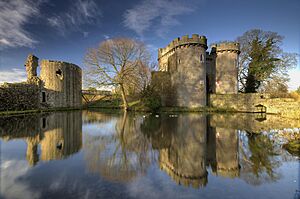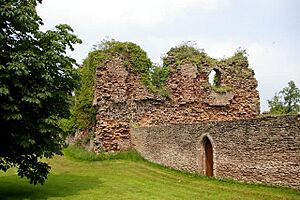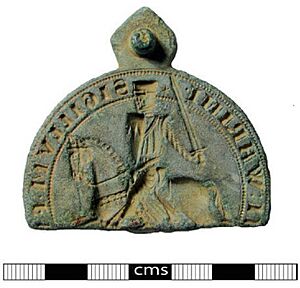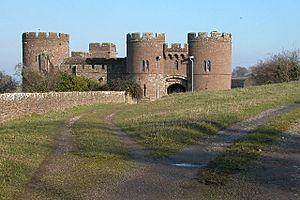Fulk FitzWarin facts for kids
```wikitext
Fulk FitzWarin (born around 1160, died 1258), also known as Fulk III, was a famous knight and lord who lived near the border of England and Wales. He was especially connected to lands in Shropshire and Alveston in Gloucestershire. When he was younger, around 1200–1203, during the early years of King John's rule (1199–1216), Fulk became known as an outlaw. He led a group of followers to try and get back his family's castle, Whittington Castle in Shropshire. King John had given this castle away to a Welsh leader.
Over time, Fulk was forgiven by the King and got to enjoy his lands again. However, he faced more challenges between 1215 and 1217. Later, his connections with Llywelyn ap Iorwerth, the Prince of Wales, and his helpfulness to the English king, put him in the middle of bigger conflicts. He even lost Whittington Castle to Llywelyn for a year in 1223–1224. It was even said that Llywelyn married Fulk's daughter.
In the 1220s, Fulk started Alberbury Priory in Shropshire. This was a small monastery that belonged to the Order of Grandmont. Fulk was always ready to protect his rights. He lived to be very old and was buried at Alberbury next to his two wives. He left behind children and many descendants who continued to use the name Fulk FitzWarin for centuries. His grandson was Fulk V FitzWarin, 1st Baron FitzWarin (1251–1315).
After he died, Fulk became the main character of a popular story called Fouke le Fitz Waryn. This story, originally a French poem, told about his life as an outlaw and his fight to get his family's lands back from the king. The story still exists today in a prose (written like a book) version. It mixes real historical events with exciting legends and fantastical parts, making it more of a heroic tale than a strict biography.
Who Was Fulk FitzWarin?
Family Roots and Early Life
The name FitzWarin means "son of Warin." Fulk's grandfather, Fulk I FitzWarin, was the one whose father was named Warin, or Guarine, from Metz in Lorraine. Warin is a bit of a mystery, and not much is known about him. The FitzWarin family is generally thought to have come to England during the time of William the Conqueror (1066-1087). At first, they were not very important lords, but later kings gave them more lands.
Fulk I was connected to the Peverel family. King Henry II rewarded Fulk I for supporting Empress Matilda during a civil war. He gave Fulk I the royal lands of Alveston in Gloucestershire and Whadborough in Loddington, Leicestershire. His son, Fulk II, took over these properties after his father died in 1171.
Fulk II married Hawise before 1178. She was one of two daughters of Josce de Dinan. Josce had held Ludlow Castle for Empress Matilda during the civil war. Instead of Ludlow, King Henry II gave Josce the large estate of Lambourn in Berkshire. After Josce died, Lambourn was divided between his daughters, Hawise and Sybil. Fulk II and Hawise de Dinan were the parents of Fulk FitzWarin III, our main character.
A Royal Chess Game
The FitzWaryn Romance story says that Fulk II and Hawise lived close to the king. Their sons were Fulk, William, Philip, John, and Alan. The story also says that young Fulk grew up with King Henry's four sons. Everyone loved Fulk, except for Prince John (born 1166).
The tale goes that Fulk and John were playing chess and got into a fight. John hit Fulk on the head with the chessboard! Fulk then kicked John in the stomach, and John fell back, hitting his head on the wall. John ran to tell his father, King Henry, who then had John beaten for complaining. This fun story shows that Fulk and John had a difficult relationship from a young age.
Fulk's Adventures
The Fight for Whittington Castle
Fulk II had many problems getting back his family's lands. One of these was Whittington Castle, located north-east of Oswestry. This castle was on the English side of Offa's Dyke, an old border between England and Wales. In 1165, King Henry II gave Whittington Castle to Roger de Powys, a Welsh leader.
Fulk II tried to get Whittington back, but he died before he could. So, Fulk III continued his father's claim. In 1197, he offered a large sum of money to get it as his inheritance. However, on April 11, 1200, King John gave the castle to Meurig, Roger of Powis's son, who offered less money. After Meurig died, King John gave it to Meurig's son, Werennoc.
Becoming an Outlaw
King John's refusal to give Fulk his family's castle made Fulk openly defy the King by April 1201. Fulk was joined by about 52 followers, including his brothers William, Phillip, and John, as well as his cousins and many family tenants. While the Fouke story talks a lot about this uprising, other historical records don't give many details.
Fulk's rebellion was serious enough that when King John went to France in 1201, he ordered 100 knights to stop Fulk and his group. In 1202, Fulk had to escape by sea and found safety in Stanley Abbey in Wiltshire. The king's forces surrounded him there, but the Archbishop helped him escape. Fulk then quietly went to join the King of France.
Eventually, Fulk and many of his followers were pardoned in November 1203. Finally, in October 1204, after paying a large fine, Fulk received his "right and inheritance" to Whittington Castle. The castle stayed with the FitzWarin family for many generations.
Marriage and Royal Service
Around 1207, Fulk III married Maud (Matilda). She was the daughter of Robert le Vavasour and the widow of Theobald Walter, a powerful lord in Ireland. Maud's lands included parts of Ireland, Norfolk, and Lancashire. Fulk had to pay a huge fine for this marriage, showing how important he was becoming. Many powerful lords supported him.
In 1210, Fulk went with King John to Ireland. In 1213, the king even gave Fulk wood from a forest to build a house at Narborough in Leicestershire.
In 1214, Fulk was among the barons who went with King John to France. He was also among the unhappy barons who wanted King John to listen to their complaints. By December 1215, Fulk's name was on a list of English barons who were excommunicated (kicked out of the church) by the Pope because they opposed the king.
More Conflicts and Peace
In 1215, Fulk caused a lot of trouble for the Sheriff of Shropshire. His lands were taken by the crown. However, by 1218, Fulk had made peace with the new young king, Henry III, and his lands were given back. He also got back the right to hold a market at Narborough and a fair at Lambourn.
By 1220, Fulk was back in the young King Henry III's good graces. He was allowed to rebuild and strengthen Whittington Castle and hold a weekly market and annual fair there. In 1223, Llywelyn the Great, the Prince of Wales, captured Whittington Castle, but it was soon returned to Fulk. Fulk's disagreements with Llywelyn continued, and some of Fulk's lands were taken by the king.
Fulk wanted his son, Fulk, to marry Anghared, the daughter of Madog ap Griffin, but Llywelyn tried to stop this. By 1228, a truce (a temporary peace) was made between Fulk, Thomas Corbet, and Llywelyn, with the king's help.
Fulk's relationship with the King often changed depending on the situation in Wales. As a "marcher lord" (a lord living on the border), Fulk's job was to protect the English border from the Welsh. This made him very important to the English King. He helped settle several border disputes for the King. Even though they had personal disagreements, Fulk III did not rebel against the king again.
Building Alberbury Priory
Between 1221 and 1226, Fulk started building his monastery, Alberbury Priory, on a moated site (a site surrounded by a ditch filled with water) by the river Severn. He first wanted it to be a house for Augustinian canons (a type of monk). However, his gifts of land were not enough. So, Fulk decided to build it for the Grandmontine Order instead.
Fulk gave the priory lands and rights in Alberbury, a fishing spot in the Severn river, and the right to build mills. He also gave them his manor of Whadborough in Leicestershire. King Henry III confirmed these gifts in 1232. The Castle in Alberbury, which is now a ruin, is also thought to have been built by Fulk III as his main home in the area.
Later Life and Second Marriage
In 1226, Fulk FitzWarin's first wife, Maud, died. She was buried at Alberbury Priory. After her death, Fulk's daughter, Hawise, inherited the manor of Narborough. Hawise married William Pantolf and later Hubert Husse.
Fulk's second wife was Clarice de Auberville. The old story says she was a very kind lady. It also says that after they married, Fulk became blind for the last seven years of his life and that he lived one year longer than Clarice. Clarice was the daughter of Sir Robert de Auberville, a powerful Norman family member.
In 1245, Fulk was chosen by a group of nobles to go to London and tell a church official named Martin to leave England. As the story goes, Fulk told Martin to leave immediately, or he would be "utterly brought down." Martin hurried to the king, who told him he had almost caused a revolt. When Martin asked for safe passage, the King supposedly replied, "May the Devil take you to hell."
Death and Burial
Historians believe Fulk FitzWarin most likely died in 1258. He probably handed over some of his duties to his son, Fulk IV, before he passed away. According to the old story, his second wife, Clarice, died before him. She was buried at Alberbury Priory. Fulk died a year later and was laid to rest beside both of his wives in the monastery church.
Fulk's Family
Fulk III FitzWarin first married Maud (Matilda) le Vavasour around 1207. She died in 1226 and was buried at Alberbury Priory. Their children included:
- Fulk IV FitzWarin (died 1264). He inherited the manor of Edlington, Yorkshire. He married Constance de Tosny and was the father of Fulk V FitzWarin, 1st Baron FitzWarin.
- Hawise FitzWarin. She married William Pantulf (who died in 1233) and then Hubert Huse. She received the manor of Narborough.
- Joan FitzWarin. She married Sir Henry de Penebrugge, from Pembridge Castle, Herefordshire.
- Eleanor FitzWarin. She married William de Rivers.
- Eve FitzWarin. She married William de Blanchminister. The old stories say she first married Llywelyn ap Iorwerth, the Prince of Wales.
Fulk's second marriage was to Clarice de Auberville. She was the daughter of Robert de Auberville. Fulk had one daughter with Clarice:
- Mabel FitzWarin (died 1297). She married William de Crevequer and then John Tregoz. She received the manor of Lambourn.
The Story of Fouke le Fitz Waryn
In the late 1200s, when people still remembered Fulk's life, a heroic story called Fouke le Fitz Waryn was written about him. It was probably first a French poem. Today, we have an early 1300s French prose (storybook) version. This story was very popular in the Middle Ages.
The Fouke le Fitz Waryn story is built around real historical events and facts, but it's not a completely accurate history book. It includes exciting adventures and legendary elements. It's part of a group of stories sometimes called the "Matter of England," which are tales about English heroes. The story shows that Fulk's world was a mix of English, Welsh, French, and Latin cultures.
About one-third of the story sets the scene for Fulk's life, talking about his father and grandfather and their connections with other powerful families. The main themes of the story are being an outlaw, losing and getting back lands, adventure, and sometimes religious devotion. The story ends with Fulk's second marriage, his blindness, death, and burial at Alberbury. It includes tales of mysterious lands, imprisoned maidens, and prophecies, similar to other knightly romances. Some parts of the story have even been compared to the legends of Robin Hood. ```






